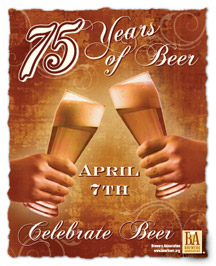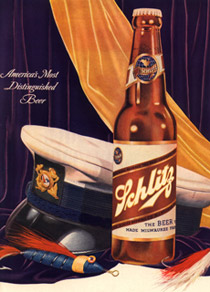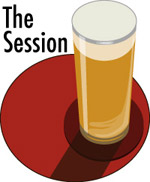Let’s start with what the brewer has to say: Matt Brophy of Flying Dog Ales talks about the intent behind the seasonal Garde Dog, as well as the way it tastes to him.
Please notice that near the end he says, “We put our own spin on it.”
Not to duck Christopher’s call for less description/background and more guidance/criticism, but how you rate this beer depends in part on what you expect from it. Had I sampled it looking for one designed to replicate Lost Abbey’s Avant Garde I would have been disappointed and likely suggested “thumbs down.”
But I like the Garde Dog. If I could buy it fresh (many Flying Dog seasonals don’t reach New Mexico, and you always have to worry about how they’ve been treated) I would. So if we are treating this like a light switch, good or bad, this beer is good. Unlike the previous biere de garde I drank, Castelain Blond, a generally dependable beer that was old, lifeless and a bit sour.
Like many other beer bloggers (just do a Technorati search) I received a bottle directly from Flying Dog, assuring freshness. I prefer it that way.
It’s no wimp at 5.8% abv, but not as strong (and hence as complex) as more traditional versions. Perhaps the flavor is a bit fruity for the style, but it blends well with lager malt sweetness and spicy hops, leaving an impression of fresh bread. Maybe it’s going to taste earthier after some time in the bottle . . . although since it’s capped rather than corked there’s less chance it will take on a musty character (or is that TCA?) that would make it more “authentic.”
By then it will be up to somebody else to tell you it is good. And I may well not agree.
 You’ve probably heard about this: Today is the 75th anniversary of when breweries could resume selling beer, although it was months later until Prohibition officially ended and full strength beer returned.
You’ve probably heard about this: Today is the 75th anniversary of when breweries could resume selling beer, although it was months later until Prohibition officially ended and full strength beer returned. – Rumors
– Rumors  Jeff Bell/Stonch has posted the roundup for
Jeff Bell/Stonch has posted the roundup for  Red Tractor beer is not a brand in the UK (as opposed to the Palisade Red Truck IPA from Colorado), but a stamp that assures it is made only with British ingredients that have been checked for quality assurance.
Red Tractor beer is not a brand in the UK (as opposed to the Palisade Red Truck IPA from Colorado), but a stamp that assures it is made only with British ingredients that have been checked for quality assurance.